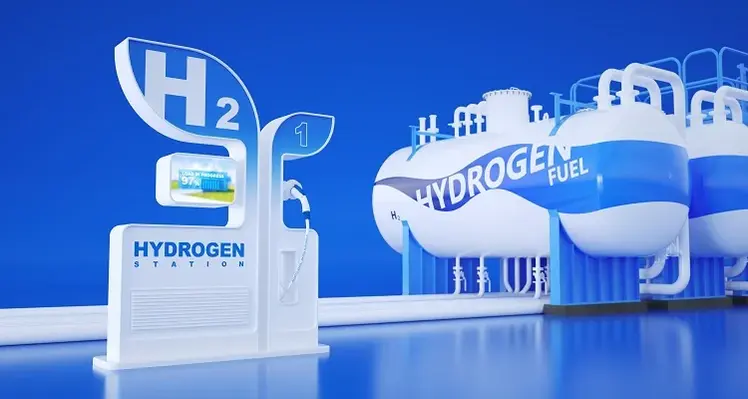Andrew Dennant, general manager for HIMA Middle East FZE highlights the need for advanced safety systems to be integrated into the hydrogen value chain to ensure the successful and secure adoption of hydrogen in line with the UAE's sustainability goals
As the global energy landscape transitions toward sustainability, hydrogen has emerged as a promising resource, particularly for nations such as the UAE, where clean energy and sustainability are central to national priorities. While hydrogen offers substantial potential as an energy source and reduces carbon emissions, its safe use requires advanced functional safety solutions, especially in large-scale industrial applications.
The role of hydrogen in a sustainable future
Hydrogen is gaining increasing attention as a viable alternative to traditional fossil fuels. Currently, most hydrogen used in industrial processes is derived from natural gas, commonly called grey hydrogen. However, green hydrogen, produced from water using renewable energy sources such as wind or solar power, is becoming increasingly significant. This process enables a substantial reduction in carbon emissions, positioning green hydrogen as a key component in the transition to a global zero-emission energy system.
In the UAE, green hydrogen is expected to play a crucial role in decarbonising various sectors, including power generation, transportation and heavy industry. While hydrogen’s adoption remains limited, its use is anticipated to grow significantly as both technology and infrastructure continue to evolve.
Safe use of hydrogen in industrial applications
Hydrogen is already widely utilised in industrial processes, such as ammonia production for fertilisers and in high-temperature manufacturing processes. Despite its advantages, hydrogen poses unique safety challenges due to its highly flammable nature. Leaks or uncontained releases of hydrogen can result in significant safety hazards. Therefore, hydrogen must be handled with the utmost care during production, storage and transportation.
Ensuring the safe use of hydrogen in industrial settings requires the deployment of advanced safety solutions. These systems must be designed to mitigate the specific application risks if hydrogen is to be used safely throughout their entire lifecycle.
Functional safety solutions for hydrogen
In large-scale operations, such as power plants or industrial facilities, advanced safety systems are essential for managing the inherent risks of hydrogen. A key example is the hydrogen production process, which involves the use of electrolysers to split water into hydrogen and oxygen. These systems require comprehensive safety functions to monitor and safeguard critical factors such as pressure and temperature. As the scale of hydrogen production increases, the complexity and sophistication of safety systems must evolve to match the rising risks associated with large-scale operations.
Transportation and storage: the key challenges
Transportation and storage of hydrogen present additional safety challenges. Due to hydrogen’s molecular properties, it is a highly permeable gas that can leak through even the smallest of cracks in pipelines, posing significant risks. To prevent leaks, advanced leak detection systems are essential. These systems monitor pipelines and storage tanks, providing early warnings and enabling swift corrective action in the event of a leak. Hydrogen storage also requires specialised safety measures. Safety protocols must ensure that storage facilities are equipped with fail-safe systems to mitigate potential risks.
Hydrogen in public transportation: safe and clean
In the UAE, hydrogen is being explored as an alternative fuel for public transportation. Hydrogen-powered buses, trains and other vehicles offer a cleaner alternative to conventional fossil fuel-powered transportation, especially in urban areas where reducing emissions is a priority. However, the integration of hydrogen into public transportation systems requires careful planning and implementation of advanced safety measures.
Safety systems must be developed to manage the use of electricity or hydrogen, depending on the infrastructure. In areas without such infrastructure, hydrogen may serve as the primary energy source. This hybrid approach ensures the safe and efficient operation of hydrogen-powered transportation.
Smart security for safe hydrogen use
As the use of digital technologies and automation in hydrogen systems increases, cybersecurity becomes an increasingly critical aspect of functional safety. The potential for cyberattacks on hydrogen production, storage and transportation systems presents a significant risk to safe and reliable operations. Therefore, it is essential to implement robust cybersecurity measures to protect these systems from malicious threats.
As the UAE continues to innovate in hydrogen technology, safeguarding these systems from cyber threats will be as crucial as the physical safety protocols in place to protect against other risks.
Looking ahead
The UAE is well-positioned to become a global leader in hydrogen production, particularly with its strong commitment to clean energy. However, to fully realise the potential of hydrogen as a key component of the UAE’s energy strategy, advanced safety solutions must be integrated across the entire hydrogen value chain. From production and storage to transportation and end use, these safety systems must evolve in tandem with technological advancements to mitigate risks and ensure the safe and efficient use of hydrogen.
By prioritising functional safety solutions, the UAE can lead by example in demonstrating how hydrogen can be safely and effectively harnessed as a clean energy source, further supporting the nation’s ambitious energy goals and contributing to global efforts toward a sustainable, zero-emission future.









